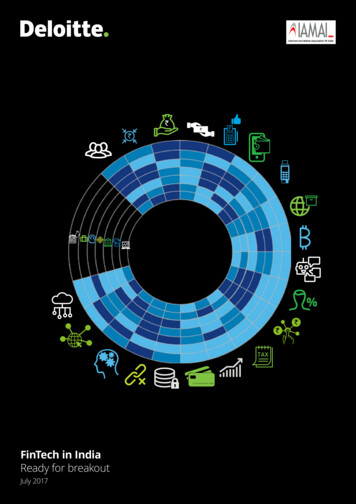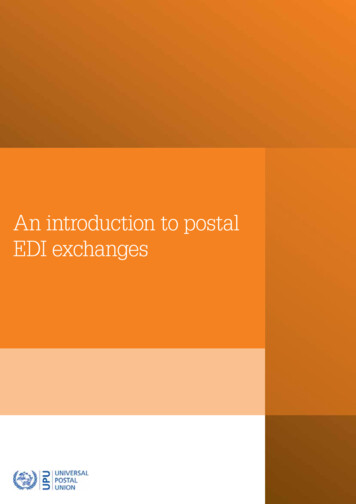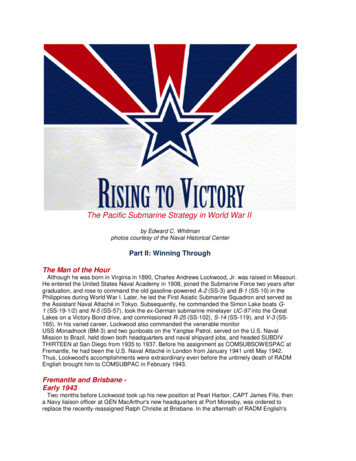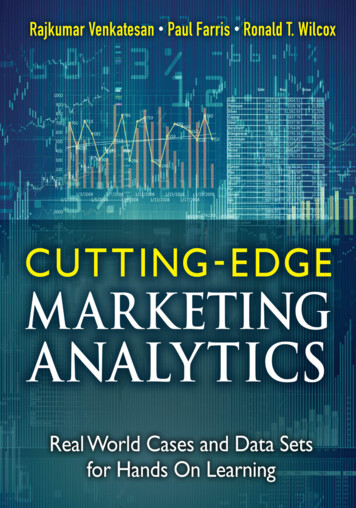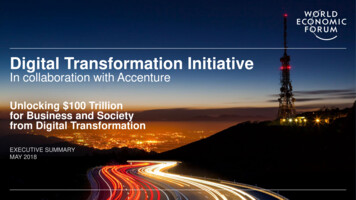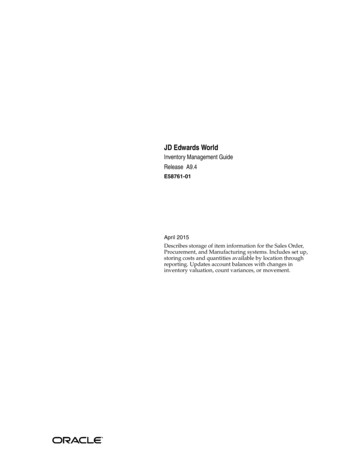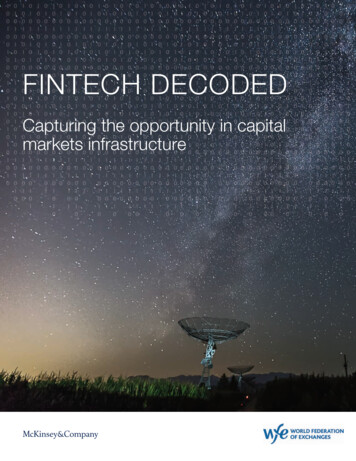
Transcription
FINTECH DECODEDCapturing the opportunity in capitalmarkets infrastructure
ContentsExecutive summary3Fintechs and the CMI value chain7Bucking the trend of a slowing broader fintech funding market10Fintechs: Friend or foe?11The impact of large technology companies13Innovation across the value chain14Identifying the fintech opportunity21Capturing the fintech opportunity25Fintech decoded: Capturing the opportunity in capital markets infrastructure1
Executive summaryTechnology has long been the engine drivingcapital markets efficiency—both for investorsin the markets, and for the capital marketsinfrastructure providers (CMIPs) that operatethe exchanges and other trading venues,central counterparties, securities depositories,index providers, and data and analyticscompanies. More lately, fintechs are bringingnew technologies to market even faster andwith a greater impact. Hundreds of fintechs arefocusing their development on capital marketsinfrastructure (CMI), and while CMIPs recognizethat fintech will have a significant influence onthe industry, many remain unsure of whichtechnologies to adopt and to what degree,and how best to engage and interact withfintech companies.of over-the-counter [OTC] derivatives or everincreasing reporting requirements), in theinvestor landscape (e.g., a higher profile forbuy-side firms) and in customer behavior (e.g., anincreasing call for data and analytics solutions).In the coming years, many CMIPs will seekto protect their businesses, and achieve evenhigher levels of efficiency, service provision,and growth, through innovation and adoptionof new technologies, some of which may proverevolutionary. These technologies will comefrom current technology leaders that tailor theirservices to CMI applications, from firms’ internaldevelopment, and from the new generationof fintechs.Capital markets infrastructureThe capital markets infrastructure (CMI)industry comprises a global network oforganizations that handle and safeguard theworld’s investments. These organizationscarry out the execution of trades, clearsecurities positions and settle payments,take custody of assets, and facilitatethese functions with secure networks fortransactions, communications, data analytics,and value-added services (e.g., regulatoryservices and corporate solutions).The role and importance of CMIPs in themarkets has grown in the past decade—alongwith their revenues—owing to changes in theregulatory environment (e.g., a push towardsmandatory central counterparty [CCP] clearingCMI providers (CMIPs) include traditionalexchanges and alternative trading venues,interdealer brokers, broker-dealer tradingplatforms, providers of order managementsystems, central counterparties and clearinghouses, securities depositories, and securitiesservices firms. An important opportunity,for both exchanges and independent firms,arises from information services, ranging fromstreams of data on market transactions andmarket indices via financial and economicnews to advanced analytics that developvalue-added information.This report evaluates the fintech landscape withinthe CMIP industry, potential uses of the newtechnologies across the industry value chain,and some of the areas likely to see the mostinnovation. Although growth in fintech investmentFintech decoded: Capturing the opportunity in capital markets infrastructure3
across the broader financial services sector hasslowed since 2015 due to investor caution overa more uncertain macroeconomic environment,the growth trajectory of CMI fintech has remainedsteep, and likely has yet to reach a peak.We have identified four fintech themes shapingthe CMI value chain. Some of these themesincrease productivity and lower costs, whileothers generate new sources of revenue: The use of advanced analytics andartificial intelligence (AI) is set for rapidgrowth, as the amount of available datacirculating through capital markets grows, andamid increasing interest in the application ofadvanced analytics to market, financial, andeconomic data. Distributed ledger technology (DLT)is applied to a range of CMI operations.Use cases include clearing and settlement,alternatives to the traditional markets foraccess to capital (initial coin offerings [ICOs]),and new digital markets. Fintechs will bring greater efficiency throughinnovative technologies such as cloud andquantum computing—for example, in thesphere of matching technologies—whiledriving depth in traded markets and expansiontowards new asset classes. Post-trade services will gain in productivitythrough the application of automation androbotics. A separate branch of regulatorytech firms (regtechs) will bring efficiencyand uniformity to risk management andregulatory reporting.To date, the fintechs most active in CMI aresmaller start-ups. For the purposes of this report,CMI-related fintechs are defined as companiesfounded since 2000 that are unlisted, employ4fewer than 1,000 people, and operate outsidethe areas of robo-advisory, brokerage, andforeign-exchange trading. Most are developingproducts as components within the CMI industry,and appear to be mainly interested in workingtogether with existing providers, rather than inpoaching their customers. Still unclear, however,are the interests and intentions in CMI of theglobal tech giants, such as Amazon, Google,and Microsoft, and whether they might ventureinto the core of the industry at scale. Given theirgreat capital resources, deep data pools, andworld-class analytic capabilities, their entry couldsignificantly change the CMI landscape. MostCMIPs believe that it is either these tech giants orincumbents working with fintechs who have thegreatest disruptive power.This report is based on a survey of themembership of the World Federation ofExchanges (WFE) (see sidebar, “Surveymethodology”). Respondents were largelypositive about the potential of fintechs, and wereunanimous in expecting enhanced productivityor new revenues from incorporating theirtechnologies in their businesses. None sawfintechs as a threat, but instead viewed them aspotential partners and enablers of growth. Theyacknowledged, though, that the extent of theimpact is difficult to ascertain.CMIPs follow various routes to bringing fintechinto their organizations. Some firms surveyedreported relying on more than one, dependingon their view of the size and importance ofthe opportunity: Development of internal capabilities. Mostof the survey participants have establishedone or more internal groups dedicated tostudying the global fintech landscape. Onlya few indicated they were aggressivelydeveloping new technologies themselves, asthis is a resource-heavy approach.Fintech decoded: Capturing the opportunity in capital markets infrastructure
Survey methodologyThe study that underpins this report wasdeveloped jointly by the World Federation ofExchanges (WFE) and McKinsey. The WFE isthe global industry association for exchangesand clearing houses, representing over200 market infrastructure providers, includingstandalone central counterparties (CCPs)that are not part of exchange groups. TheWFE advocates on behalf of its members andframes industry guidelines, best practices, andstandards, in addition to supporting marketdevelopment. McKinsey is a global managementconsulting firm that helps its clients significantlyand sustainably improve their performance andachieve their goals. McKinsey has supportedCMIPs in more than 400 projects over the pasteight years.Amidst continuous debate on the disruptivepower of fintech, this report aims to demystifythese new technologies. It examinesopportunities for CMIPs to use fintech to achievegreater efficiency and enhanced client service,and to work with and invest in fintechs.The insights have been derived from ananonymous survey of 46 WFE membersworldwide as well as in-person interviews withstaff of WFE members and McKinsey experts.The survey consisted of 24 questions. Twentyof the 46 survey participants are based in Asia,10 in the Americas, and 16 in Europe, MiddleEast, and Africa. Readers interested in furtherdetail can contact the WFE or McKinsey.The analysis of the fintech landscape isbased primarily on the McKinsey PanoramaFintech database, which catalogs more than6,000 fintech innovations globally. It categorizessolutions along nine dimensions, according towhere they fall on the value chain, technologiesused, or customer segments served.Demographics of survey participantsHeadquarters locationHow would you rate your understanding of thefintech landscape?Share in percent, n 46Share in percent, n iateSource: WFE-McKinsey Fintech survey 2017Fintech decoded: Capturing the opportunity in capital markets infrastructure5
Collaboration and joint ventures. Fortypercent of the WFE members surveyedbelieve that collaboration is the most efficientapproach to fintech, followed by joint venturesat 25 percent. The primary reason citedis a shortage of resources, inhibiting thedevelopment of their own solutions. Moreover,the speed of innovation is rapid, and diversetalents are needed for internal development. Minority or majority financial investment.Of the 46 WFE members surveyed, 11 saidthey are investing in fintechs through minoritystakes, while 10 said they use majorityinvestments (multiple choices were allowed).Most innovations may fail, but one or twoare likely to become success stories, WFEmembers said. Outright acquisition. Just 9 percent ofsurvey participants cited acquisition offintechs as the most effective approach.6The fintech landscape is evolving at anaccelerated pace, as new firms and innovationsenter the market while others drop out, andideas are rapidly developed and deployed. Oneapproach to a successful CMIP fintech strategycalls for a “portfolio of initiatives”: incumbentsinvest in multiple fintechs of different sizes, timehorizons, and objectives—some with a short-termfocus aimed at enhancing the core business,and others with longer-term objectives basedon a smaller number of revolutionary ideas.With so many fintechs in the market and moreto come, a structured approach is essential toidentify the technologies best suited to a CMIP’sstrategy and operations. It is also important todetermine which projects to develop internallyor through reliance on fintechs, and what formthe relationship and investment in fintechsshould take.Fintech decoded: Capturing the opportunity in capital markets infrastructure
Fintechs and the CMI value chainThe McKinsey Panorama Fintech database coversover 6,000 of the more than 12,000 fintechinnovations in the global marketplace. Based ontheir activities and technologies, about 700 fintechsare relevant to the CMI industry. Through steadygrowth totaling 277 percent, this number hasalmost quadrupled since 2010, and has outpacedother areas of fintech within financial services, suchas corporate banking (growth of 186 percent), andpayments (184 percent) (Exhibit 1).In this report, we look at where fintechs reside onthe CMI value chain, and analyze the technologiesthey rely upon. The distinction between locationon the value chain and technologies used indevelopment is essential to a full understandingof the CMI fintech universe. Certain technologies,such as DLT, are a component of CMI fintechproducts and services, rather than end productsin their own right. In other instances, significantproduct innovation can be achieved without theuse of new technologies—one prominent examplebeing the crowdfunding platforms that haveemerged in the last several years.Fintech-led innovation can be found in all fivemajor parts of the CMI value chain (Exhibit 2): Access to capital—creating innovative waysto reach and serve issuers and investors, andbroadening the range of asset classes offered Trade execution—gaining new efficiencies Post-trade services—bringing simplification,automation, and improved security toincumbents’ operations Data, analytics, and informationservices—developing new techniques tomine and interpret data to its full potential Operations and technology—creatinggreater cost efficiency, lower latency, andreduced operational riskExhibit 1Fintech activity within capital markets infrastructure has grown byalmost 300% since 2010Cumulative number of CMI-related fintechs, indexedNumber of fintechs, indexed2010 1002010 1002010356377303286238 18613210020122013284 277%179Prior 2011to 20102016201420152016 184100100CorporatebankingPaymentsSource: McKinsey Panorama Fintech databaseFintech decoded: Capturing the opportunity in capital markets infrastructure7
Exhibit 2Innovation is occurring across the entire CMI value chainAccess to capitalCrowdfunding platformsStart-up exchangevenuesBond issuance platformsfor start-ups and SMEsPrivate listing platformsfor SMEsTrade executionPost-trade servicesDecentralized tradingmarketplacesDistributed ledgertechnology-basedclearing and settlementOnline itial coin offeringplatformsData, analytics, andinformation servicesAlgorithmic and quanttrading solutionsSurveillance andanalytics softwareArtificialintelligence-poweredfinancial predictionsAutomated tradereconstructionReal-time market dataplatformsRegulatory compliancesolutions (e.g., AML,KYC, compliance risk)Nontraditional dataaggregation andanalytics platformsOperations and technologyOpen source technology for digital assets issuanceEnd-to-end trading technologyEnd-to-end OTC trade confirmations solutions through full process automationRobotics and natural-language processing technologies driving operations efficiencyCloud computingSource: McKinsey Panorama Fintech databaseAccording the McKinsey Panorama Fintechdatabase, the density of fintechs is greatestin access to capital, at 37 percent of all CMIfintechs, followed by trade execution, data,analytics and information services, and posttrade services. By contrast, WFE membersperceive little fintech activity in access to capital(just 3 percent),
Use cases include clearing and settlement, alternatives to the traditional markets for access to capital (initial coin offerings [ICOs]), . According the McKinsey Panorama Fintech database, the density of fintechs is greatest in access to capital, at 37 percent of all CMI fintechs, followed by trade execution, data, analytics and information services, and post-trade services. By contrast .
